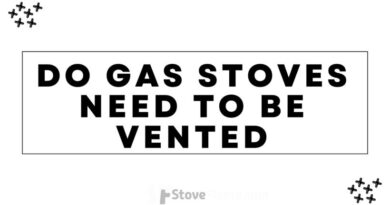What Size Gas Pipe for Stove?
When it comes to installing a gas stove, one of the most important factors to consider is the size of the gas pipe. A properly sized gas pipe is crucial for the safe and efficient functioning of your stove. With the increasing popularity of gas stoves in homes and commercial kitchens, it is essential to understand how to determine the right size gas pipe for your stove.
In this article, we’re going to discuss the different factors that play a role in choosing the right size gas pipe, why accurate sizing is crucial, and how to find the perfect fit for your stove.
Whether you’re a homeowner planning to install a new gas stove or a construction professional, we’re here to give you all the information you need to make sure your gas stove is connected to the correct gas pipe size for the best performance. Let’s explore the key considerations to keep in mind when determining the ideal gas pipe size for your stove.
What is Stove Gas Pipe Used For?
Stove gas pipes play a crucial role in safely delivering gas from your home’s gas supply to your stove. They are designed to handle the high pressure and flow rate required to feed gas to the burners efficiently. Stove gas pipes are typically made of durable materials such as steel or copper, which are resistant to corrosion and can withstand the heat generated by the stove.
These pipes are essential for ensuring that the gas reaches your stove without any leaks or interruptions, allowing you to cook your meals with ease and peace of mind. Additionally, stove gas pipes are often equipped with valves and fittings that allow for easy connection and disconnection, making maintenance and repairs simpler when needed.
Type of Stove (Gas or Dual Fuel)
When it comes to choosing the type of stove for your kitchen, one important consideration is whether to opt for a gas stove or a dual fuel stove. Gas stoves are known for their quick and precise temperature control, allowing you to adjust the flame instantly to achieve the desired heat level for your cooking. They are also generally more cost-effective to operate compared to electric stoves.
On the other hand, dual fuel stoves combine the best of both worlds by offering a gas cooktop for precise cooking and an electric oven for consistent baking. This versatility can be a great advantage for those who enjoy a variety of cooking techniques. Ultimately, the choice between gas and dual fuel stoves depends on your cooking preferences and needs.
Importance of Choosing the Right Gas Pipe Size for a Stove
Ensuring that you choose the right gas pipe size for your stove is of utmost importance. A properly sized gas pipe allows for efficient and safe fuel delivery to your stove, ensuring optimal performance and reliability.
If the gas pipe is too small, it may restrict the flow of gas, leading to inadequate heat output and slower cooking times.
On the other hand, if the gas pipe is too large, it can result in excessive gas pressure, which can be dangerous and potentially cause leaks or even explosions. By selecting the correct gas pipe size, you can ensure that your stove operates at its best, providing you with the precise cooking temperatures you need while maintaining the safety of your kitchen.
What Size Gas Pipe for Stove?
When determining the appropriate gas pipe size for your stove, there are several factors to consider. Firstly, you need to assess the BTU (British Thermal Unit) rating of your stove, which indicates the amount of heat it can generate. This information can usually be found in the stove’s user manual or specifications.
Additionally, you should take into account the distance between the stove and the gas line connection. Longer distances may require larger pipe sizes to maintain an adequate gas flow.
It is important to ensure that the gas line is at least 3/4″ in accordance with most building codes. If your stove has a higher gas usage, you may need an even larger gas line and a strong ventilation system to meet safety requirements. It is recommended to consult with a professional to determine the appropriate gas line size and ventilation system for your specific stove.
What is Gas Pipe Sizing Chart?
A gas pipe sizing chart is a valuable tool used in the process of determining the appropriate size of gas pipes for various applications. It provides a systematic guide that takes into consideration factors such as the BTU rating of the appliances, the length of the gas lines, and the required gas pressure.
The chart typically includes columns indicating the different pipe sizes and their corresponding maximum allowable gas flow rates or capacities. By referring to the chart, you can easily match the requirements of your stove or other gas appliances with the appropriate pipe size.
However, it’s important to note that using a gas pipe sizing chart should be done in conjunction with expert advice from a professional plumber or gas technician. They can help ensure that all relevant factors are considered and that the chosen pipe size complies with local building codes and safety standards.
Consider Distance from Gas Meter to Stove
One additional factor to consider when determining the appropriate size of gas pipe for your stove is the distance between the gas meter and the stove itself. The length of the pipe can impact the gas pressure and flow rate, which in turn can affect the stove’s performance.
It is important to ensure that the pipe is of adequate size to minimize pressure drop over longer distances. If the distance is too great, opting for a larger pipe diameter may be necessary to maintain proper gas flow and prevent any potential issues with insufficient heat or pressure.
Consulting a professional plumber or gas technician can help you accurately assess the distance and determine the appropriate gas pipe size for your stove based on your specific setup.
Type of Gas (Natural Gas vs. Propane)
When it comes to choosing the type of gas for your stove, you have two options: natural gas or propane. Natural gas is commonly used in homes that are connected to a municipal gas supply. It is convenient, as it is delivered directly to your home and requires no additional storage.
Propane, on the other hand, is a portable gas that is typically stored in tanks outside of the home. This makes it a popular choice for rural areas or locations where a natural gas supply is not available. When deciding between the two, it is important to consider factors such as availability, cost, and installation requirements. Natural gas tends to be more cost-effective and convenient for those with access to a gas supply, while propane offers flexibility and independence for those in more remote locations. Ultimately, the choice between natural gas and propane will depend on your specific needs and circumstances.
Common Sizes for Residential Stoves
Residential stoves come in a variety of sizes to accommodate different kitchen spaces and cooking needs. The most common sizes for residential stoves are 30 inches and 36 inches. A 30-inch stove is a popular choice for smaller kitchens or apartments, as it provides a compact and efficient cooking surface.
On the other hand, a 36-inch stove is ideal for larger kitchens or for those who enjoy cooking and require more burner and oven space. It’s important to consider the dimensions of your kitchen and the amount of cooking you typically do when selecting the size of your stove.
Additionally, keep in mind that the size of the stove will also impact the ventilation and clearance requirements, so be sure to consult the manufacturer’s guidelines for proper installation.
Tips for Installing a Gas Pipe for Your Stoves
When it comes to installing a gas pipe for your stove, safety should always be the top priority. Here are some helpful tips to ensure a smooth and secure installation process. First, it’s crucial to turn off the gas supply before starting any work. This will prevent any potential accidents or leaks.
Next, carefully measure and cut the gas pipe to the appropriate length, ensuring a proper fit. Use the appropriate tools, such as a pipe cutter, to achieve clean and precise cuts. When connecting the gas pipe to the stove, make sure to use a gas-rated sealant or tape to prevent any gas leaks.
Additionally, always double-check the connections to ensure they are tight and secure. Finally, it’s essential to have a professional inspect and approve the installation before using the stove. Following these tips will help you install a gas pipe for your stove safely and with peace of mind.
Wrap Up
I hope this article has provided you with a better understanding of the factors to consider when choosing the right gas pipe size for your stove. Remember to always consult a professional if you are unsure or have any concerns. By following proper guidelines and taking into account the BTU requirements, you can ensure a safe and efficient gas supply for your stove. Thank you for reading and happy cooking!
I'm Daniel Miller, the proud owner of StoveFlame. With over five years of experience in this dynamic field, I've honed my skills and passion for delivering top-notch quality and accuracy in everything I do.





